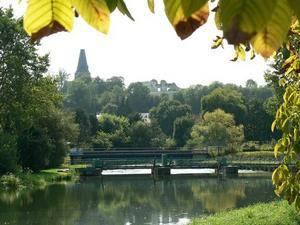Area 10.31 km² | Canton Picquigny Population (2006) 1,393 Local time Friday 1:11 PM | |
 | ||
Weather 16°C, Wind SW at 16 km/h, 63% Humidity | ||
Picquigny is a commune in the Somme department in Hauts-de-France in northern France.
Contents
Map of 80310 Picquigny, France
Geography
Picquigny is situated at the junction of the N235, the D141 and D3 roads, on the banks of the Somme River, some 8 miles (13 km) northwest (and downstream) of Amiens. A railway station also serves the town.
History
Already established as a Gallic settlement before the Romans arrived, a Gallo-Roman cemetery gallo-romain was discovered in 1895 in the area known as Les Vignes.
Known through the ages by various names, in 942 as Pinquigniacum, Pinconii castrum in 1066 and Pinchiniacum in 1110, then as Pinkeni, Pinkinei and Pecquigny .
After the defeat of the Huns at Lihons-en-Santerre, the inhabitants of Amiens, who had helped the barbarians, took refuge in the castle of Picquigny, to hide from the vengeance of Dagobert, where they were then besieged by him.
On 17 December 942, Arnulf I, Count of Flanders and William I, Duke of Normandy came to Picquigny to sign a peace treaty. They met on a small island in the Somme, having both left their armies behind. After the meeting, William left but was then assassinated by Arnulf’s supporters.
As early as the 14th century, the town had commune status and a county judge. In 1307, several Templars, were arrested and imprisoned in the dungeons of the château by order of Philip IV of France,
On 29 August 1475, with the Treaty of Picquigny, Louis XI brought to an end the Hundred Years' War. The French king had to pay King Edward IV an annual sum of fifty thousand crowns.
In 1547, Henry II of France established a market, on every second Monday of the month.
